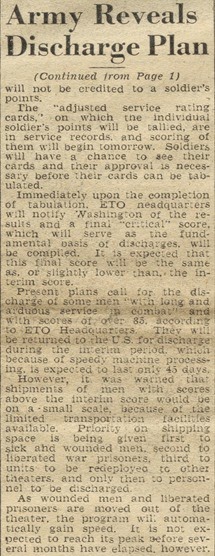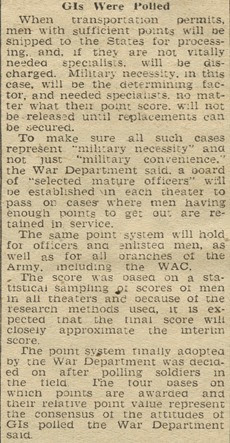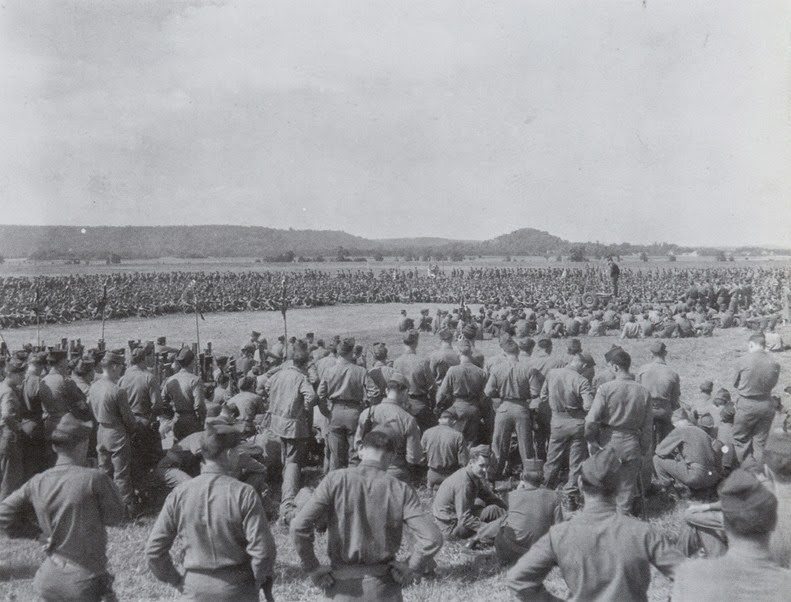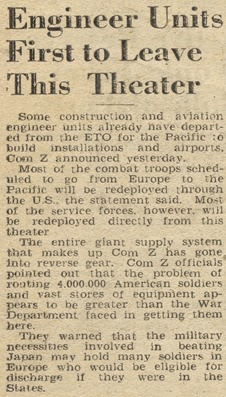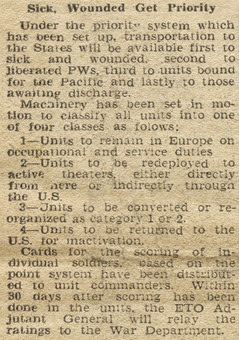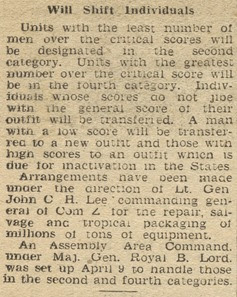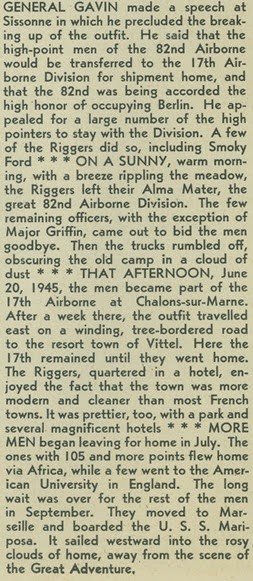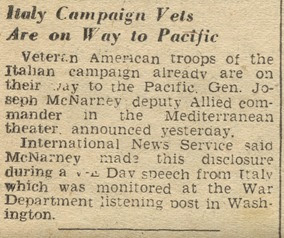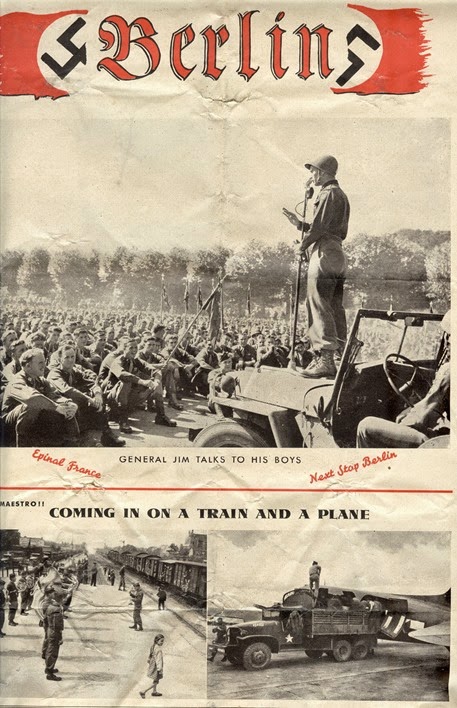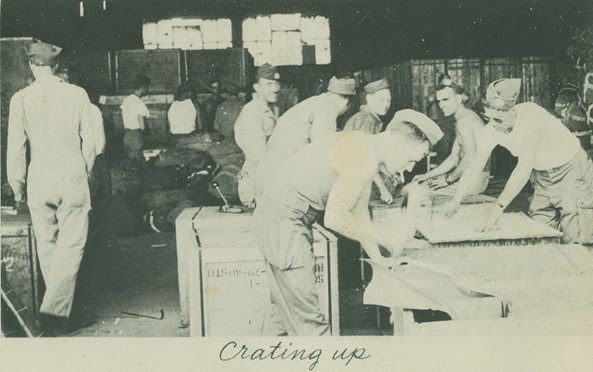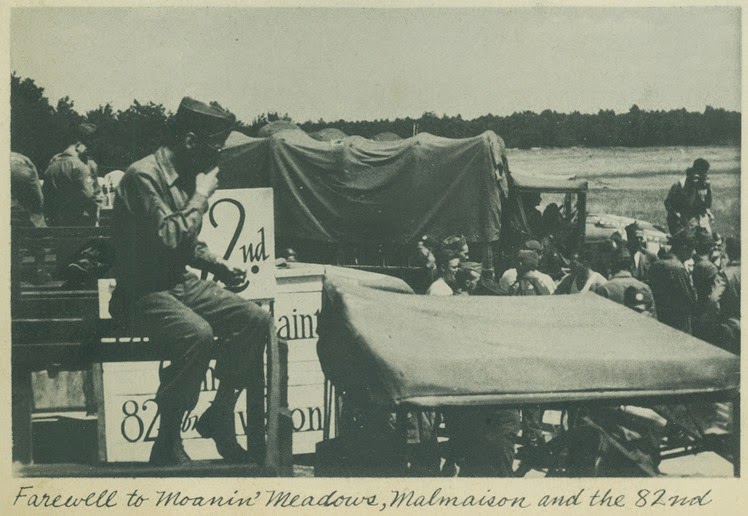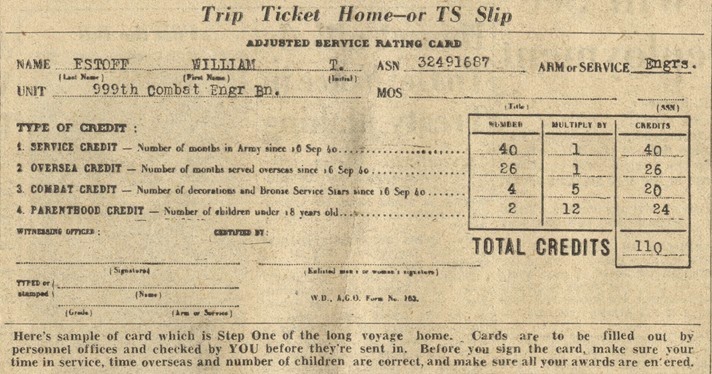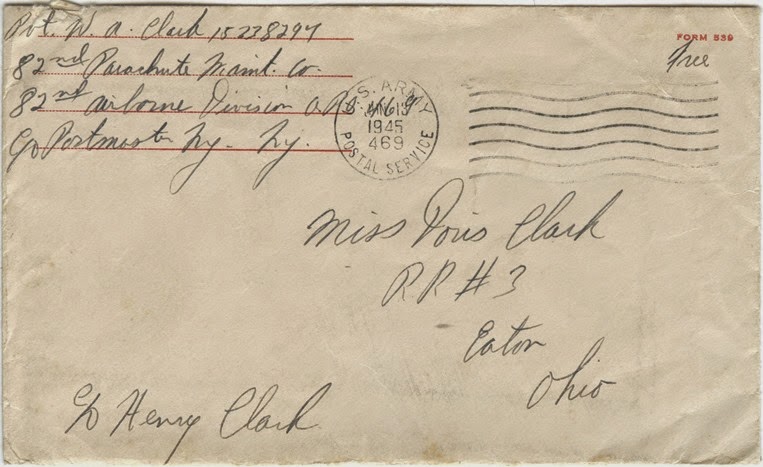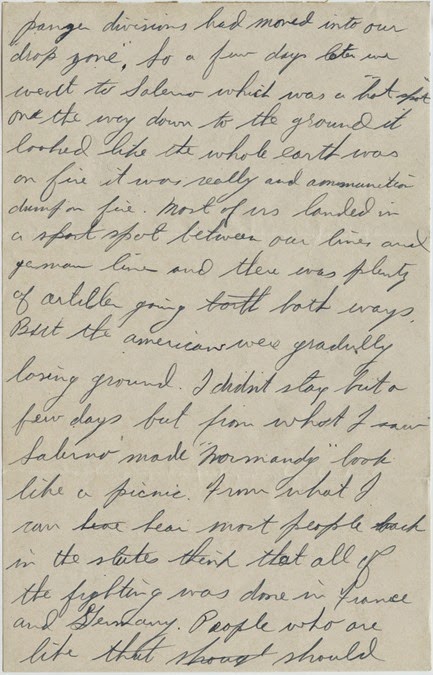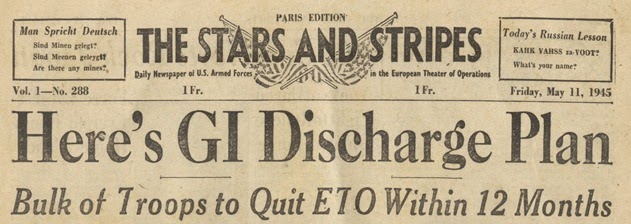 “The Stars and Stripes” Headline May 11, 1945 Source: “The Stars and Stripes”, Paris Edition, May 11, 1945. p .1 Authors collection
“The Stars and Stripes” Headline May 11, 1945 Source: “The Stars and Stripes”, Paris Edition, May 11, 1945. p .1 Authors collection
Four days after Germany’s unconditional surrender a series of articles appeared in the Friday, May 11, 1945 European editions of the “The Stars and Stripes” – the daily newspaper serving personnel in the US Armed Forces. They dealt with the question of how service men and women would be discharged from duty in the ETO.
At the heart of the matter, a points system had been devised for determining which of the soldiers deployed in the European Theater of Operations (ETO) were eligible for early discharge. It was based on a newly introduced soldier’s Adjusted Service Rating (ASR) Score card, (often erroneously called the Advanced Service Rating Score card). See Appendix A for further explanation.
Prior to the capitulation of the Japanese Empire,the ASR Score was also used to determine which soldiers were earmarked for redeployment to the Pacific for the planned invasion of Japan. Soldiers with high points could go home, while those with low points were to be reorganized and trained for deployment in the Pacific. Just how high a man’s points had to be to avoid redeployment to the Pacific was to prove a fertile question for the rumor mill and a source of worry, for high and low point men alike, in the months that followed until Japan surrendered on September 2, 1945.
Feelings of disdain swept through the Army's ranks at the fact that the details of such a momentous discharge plan came via the servicemen’s daily rag, rather than through the official chain of command. It precipitated an immediate rush of enlisted men all clamoring to check their service record and calculate their ASR Scores. The results were distressing or comforting depending on which side of the points divide one found himself. In Bill’s case the news was deeply troubling, sparking a drawn-out effort to get mistakes in his service record corrected.
The categories and criteria for earning points and the conditions for discharge eligibility were specified in the following articles, or ones similar to them, depending on which edition of “The Stars and Stripes” a person read (e.g. London, Paris, and so on):
“How to Score Points” categories and criteria for earning points towards Army discharge in post – WWII Source: “The Stars and Stripes” Paris Edition, May 11, 1945, p. 1 Authors collection
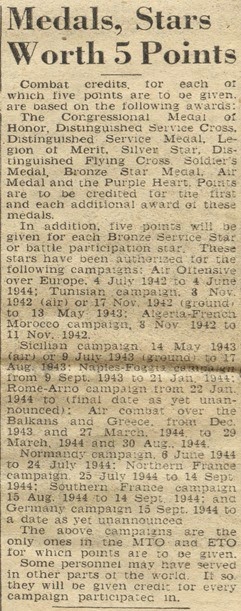 Other articles in the May 11 edition placed the start date for accruing points in these four categories at September 16, 1940 . The end date as set as May 12, 1945. The Points Discharge Plan was implemented on May 12, 1945. In addition to the battle participation star (AKA Bronze Service Star or Battle Star) in number 3 above, combat award medals which counted 5 points on a soldier’s ASR Score card were the:
Other articles in the May 11 edition placed the start date for accruing points in these four categories at September 16, 1940 . The end date as set as May 12, 1945. The Points Discharge Plan was implemented on May 12, 1945. In addition to the battle participation star (AKA Bronze Service Star or Battle Star) in number 3 above, combat award medals which counted 5 points on a soldier’s ASR Score card were the:
- Distinguished Service Cross (DSC)
- Legion of Merit
- Silver Star
- Distinguished Flying Cross (DFC)
- Soldier's Medal
- Bronze Star
- Air Medal
- Purple Heart
One significant combat award which did not count was the Combat Infantryman Badge (CIB); a fact which infuriated those men needing only five or less points to make the cut.
Medals and stars worth 5 points Source: “The Stars and Stripes”, Paris Edition, May 11, 1945. p .1 Authors collection
Articles detailing pertinent aspects of the discharge plan Source: “The Stars and Stripes”, Paris Edition, May 11, 1945. p .1 & p. 4 Authors collection
For the 82nd Troopers with 85 Points or Higher, it was Destination USA
85 points was determined as the minimum ASR Score to qualify for discharge Source: “The Stars and Stripes”, Paris Edition, May 11, 1945. p . 1 Authors collection
The 82nd Airborne Division began its return to France from its occupation duties around Ludwigslust, Germany on June 1, 1945. This time the bulk of the Division was stationed at “Camp Chicago” near Laon, a short distance from Reims, arriving there on June 5. The 82nd Parachute Maintenance Company remained at “Camp Moaning Meadows”, near Reims manning the 82nd’s parachute packing and maintenance facilities. Bill wrote a letter home dated June 12, 1945 recounting the major events and future prospects facing the Division and its men in the postwar period:
“We had a division ‘review’ or ‘parade’ to you last Saturday [June 9, 1945]. The commander [General Gavin] gave us a long talk and told us just what to expect in the future”. Source: Bill Clark Letter Dated June 12, 1945. See Appendix B.
Photo 1: The Divisional review held on Saturday, June 9, 1945 which Bill referred to in his June 12 letter Source: National Archives
Towards the end of his letter, Bill wrote:
“I almost forgot. The General said the other day [Saturday, June 9] that there is to be three divisions in Berlin: 1 American [the 82nd Airborne - a decision yet to be finalized at that date]; 1 British; and 1 Russian. If I get there I won’t leave from 6 – 9 months. I like the idea because it will be a good deal I think”. Source: Bill Clark Letter Dated June 12, 1945 See Appendix B.
When the Points Discharge Plan was published on May 11, to the best of Bill’s knowledge he had 89 points, making him a high point man. A man with less than 85 points was a low point man. High point men were eligible to go home while the low point men had to stay with the 82nd. The highest of high point men were given the option to go home almost immediately, although some of them had to wait as long as three months to find transportation. During the three weeks that the 82nd Airborne was stationed in Ludwigslust, Germany some 647 of the highest point paratroopers and glidermen were sent home. Source: LoFaro, G., “The Sword of St. Michael: The 82nd Airborne Division in World war II”, 2011, p. 554.
These very high point men departed for the US on what was known as the “Green Project”, whereby they were flown home via C- 47 or the newer four engine C- 54. Source: Wurst, S., & Wurst G., “Descending from the Clouds:A memoir of Combat in the 505 Parachute Infantry Regiment, 82nd Airborne Division”. 2004, p. 253
In his Saturday, June 9 speech, General Gavin had asked for all of the high point men to volunteer for Occupation Duty in Berlin instead of opting to go home. Thinking he had 89 points, Bill decided to do just that and put his name down as a volunteer. Rumors had been circulating that the 82nd paratroopers were going home only to be prepared for the Invasion of Japan. Bill judged the rumors were probably true and did not want to be one of those deployed to the Pacific. He thought his best option to avoid that was to volunteer for Berlin.
Transfer of High Point 82nd Men to 17th Airborne Division
The early discharge, in Ludwigslust, of its highest point troopers was a harbinger of things to come and spelled trouble for the leadership of the 82nd Airborne. Naturally, having had more time in combat than any other Airborne division, it contained most of the high point men. The 82nd had 6,000 men scoring 85 points or higher in its ranks on May 12, 1945. That was more than 50 percent of its official strength. If it continued unmanaged, implementation of the Points Discharge Plan would soon have meant there would be an insufficient number of personnel to maintain the Division. Source: LoFaro, G., “The Sword of St. Michael: The 82nd Airborne Division in World war II”, 2011, p. 554.
Conversely, at the same time, the 507th PIR of the 17th Airborne Division contained many low point men. To send the high point troopers home and keep the 82nd at sufficient strength an exchange was made between the two outfits whereby low point men of the 507th PIR were sent into units in the 82nd and high point 82nd men were placed into units of the 17th with most of them assigned to the 507th PIR. The reasoning behind the exchange was the 507th was scheduled to be deactivated and returned home, while the 82nd Airborne was to remain on active duty. Source: Nordyke, P., “All American All The Way: The Combat History of the 82nd Airborne Division in World war II” , 2005, p. 761
Over June 12 - 15, the 82nd moved again. This time to Epinal, France, some 170 miles from their old bases around Reims, and midway between the 17th Airborne bases in Vittel and Rambervillers. Then on June 21 ceremonies were held for the departing high point men. Source: Nordyke, P., “The All Americans in World War II: A Photographic History of the 82nd Airborne Division at War”, 2006, pp. 184 – 185
About 1000 of the high point men departed from the 505 alone. The same day their departing ceremonies were held, most of the men left the 82nd Airborne had made their way to the 17th Airborne camps. Source: Langdon, A. “Ready: A World War II History of the 505th Parachute Infantry Regiment”, 1986, pp. 130 – 131.
The feelings among the high point men transferring to the 507 were not altogether positive, as 82nd Division Headquarters trooper, Len Lebenson recalled:
“Joining the 17th was a comedown, since we felt we were coming from ‘the’ Airborne division to what we considered to be somewhat of a poor relation. We had to change our 82d shoulder patches from one shoulder to the other and sew the 17th [Division] Eagle Talon patch onto the left shoulder. We promptly dubbed the Talon patch the ‘$!#@ hook,’ which of course endeared us to the old 17th hands”. Source: Lebenson, L., “Surrounded by Heroes: Six Campaigns with Division Headquarters, 82nd Airborne Division, 1942 – 1945”, 2007, p. 206
A Long Two Months Awaited the High Point Men Before They Arrived Home in September, 1945
These men went to either Rambervillers, France or Vittel, France, the two places where the 17th Airborne was stationed.
View 82nd & 17th Airborne Bases June 5 - Late August 1945 in a larger map
Map 1: 82nd & 17th Airborne bases from June - August, 1945 and the 82nd Airborne Move to Epinal France from Laon.
They stayed there for almost 2 months while their transportation by sea was arranged. In late August they departed on the USS Mariposa arriving in Boston harbor in early September where they were processed and sent to discharge centers before their return to society. Source: Langdon, A. “Ready: A World War II History of the 505th Parachute Infantry Regiment”, 1986, pp. 131.
Rationale for the long two month wait the high point men endured Source: “The Stars and Stripes”, Paris Edition, May 11, 1945. p . 4 Authors collection
Bill Clark’s ‘Points’ Ordeal Begins*
* See Appendix A for the ASR Score calculator and Bill’s ASR Score breakdown
As soon as he could after May 11, Bill checked his ASR Score. He was stunned to find out he was not a high point man. It turned out that he was a low point man, but only by the slimmest of margins – a single point!
“Just the men with 85 points go home the 25th of this month [June 25, 1945]. I have 84, but still I might make it a little later on. What is left of the division after these men go will move to Berlin to do occupational duty and reform a new or almost new 82nd. Most of the old men have enough points to get out. There are only two of us in this company [82nd PMC] who came overseas with this outfit [82nd Airborne Division] and don’t have enough points to be discharged”. Source: Bill Clark Letter Dated June 12, 1945. See Appendix B
Bill tried to get his service recorded corrected to include the Purple Heart he had received in Sicily. A medal which had been considered by paratroopers as a wimpy award (due to the fact that medical personnel had been in the practice of awarding it for minor cuts and scrapes) now became crucial in calculating points for discharge. Bill continued in his letter:
“I really have 89 points but my service record is messed up. Received a ‘Purple Heart’ in Sicily which was recorded on a medical record. The First Aid Station received a direct hit from an 88 m.m. shell shortly after I left it so the records were destroyed. I think I can still get it though, but it will take a long time. I thought it was on my service records, but recently found out it wasn’t”. Source: Ibid.
All of the “old timers” (those men who had come over with the 82nd to North Africa) from the 82nd PMC, except Bill and one other man, had 85 points or higher. Most of these old men chose to leave on June 24 and join the 17th Airborne, while others decided to stay and volunteer for duty in Berlin:
“June 24, 1945, was a heartmoving (sic) day for every person in the Parachute Maintenance Company. This was the day for saying ‘Goodbye’. The ‘85ers’ and over, practically all of them the old men who had been together since before leaving the States, transferred to the 17th Airborne Division, on the first leg of the journey home, leaving only 32 under ‘85ers’ and 10 volunteers behind. Disregarding the fact that this group was most of the men in the camp, they were the core of the Company. No praise can be too high, for this group of civilians in the Army. For the impossible feats of skill and endurance they accomplished and the band of good fellowship uniting all these men.
…In return for these high point men, the 82nd Parachute Maintenance Company received 30 low point men from the 17th Airborne Division the same day. …Seventy-five enlisted men and two officers arrived a couple of weeks later. Fifty-two more men arrived in August”. Source: Author Unknown, “82nd Airborne Division: 82nd Parachute Maintenance Company” Section 1 Unit History, Date unknown, pp. 14 - 15
Even though his official ASR Score was 84 at the time, Bill believed (correctly) that he was a high point man, and that the error might be corrected soon. Therefore, a short time after General Gavin’s plea for high point men to remain with the Division and volunteer for Berlin Occupation Duty, Bill lodged his application. His reasons for volunteering were as complicated as the error in his service record. We’ll return to them later in this post.
The End of the the “Old” 82nd Parachute Maintenance Company
The unpublished history of the 82nd PMC entitled “Our Outfit” describes what happened to the men with 85 points or more:
Excerpt describing the points plan the discharge of the high point men of the 82nd PMC Source: “Our Outfit: The Story of the Parachute Riggers of the 82nd Airborne Division” unpublished manuscript p. 78. Author’s collection.
When the 82nd moved to Epinal over June 12 – 15, the 82nd Parachute Maintenance Company stayed at its Camp Moanin’ Meadows near near Sissonne along with the incoming troopers being transferred from the 17th Airborne Division. From June, 1945 until the final move to Berlin on August 11 - 16, 82nd PMC riggers could variously be found at Camp Moaning Meadows and at times in Epinal sewing new equipment for the Berlin Occupation force.
Article capturing the dismay of troopers caught on the wrong side of the points discharge plan Source: The 82nd Division Newspaper “‘The All American’ Paraglide, European Final, VE Day May 1945, 82nd ‘All American’ Division” May, 1945 p. 3. Authors Collection.
Thoughts and Feelings Among Those 82nd Men Who Remained Behind
The 82nd men of less than 85 points, were to remain with the Division. These low point men were saddened at the absence of their former brothers with whom they had endured so much. A certain melancholy stemming from a perceived loss of the 82nd Airborne’s identity pervaded the remaining ranks regardless of one’s stature as a high or low point man. For instance, with an ASR Score of 110, high pointer, Lt. James Megellas*, and newly appointed commander of H Company 504 PIR wrote home:
“…We’ve got all new low point men in the outfit now. All of the old men are gone and I don’t have a soul anymore”. Source: Megellas, J., “All The Way To Berlin: A Paratrooper at War in Europe”, 2003, p. 269.
*Lt. James “Maggie” Megellas was the most decorated officer of the 82nd Airborne Division in WWII.
At the same time, with respect to their future, many of the high point volunteers and low point 82nd men alike were feeling positive. The prospect of Occupation Duty in Berlin was thought of as a welcome break from the monotony of life on inactive duty on a base in the middle of the French countryside:
“At least duty in Berlin sounded more interesting than the make-work projects [useless activities to keep the inactive units occupied while awaiting transfer to the US] we were given in France”. Source: McKenzie, J., “On Time on target: The World War II Memoir of a Paratrooper in the 82d Airborne.” 2000, p. 184
More than a few of the high point volunteers had harbored a desire to see their journey through to the ultimate end. The Division’s leadership had long fostered the idea, and fed the rumor mill among the men that they would parachute into Berlin and capture Hitler. The cancelled Operation ECLIPSE had been designed to achieve that very same aim. General Gavin had himself contributed to the rumors of a drop on Berlin. The desire to go all the way to Berlin from their starting point in Africa ran strong in the hearts of all the old men, even at this late juncture. For most though it was overpowered by their yearning for home:
“A lot of guys thought it was a privilege to be among the elite of the elite, but I was glad I didn’t have to go [to Berlin]. I wanted to get back to my wife and family in the worst sort of way”. Source: Burriss, T., M., “Strike and Hold: A Memoir of the 82nd Airborne in World War II”, 2000, p. 192
For some of the those who did volunteer, Berlin was seen as a mandatory step towards closure that demanded to be taken. James Megelles, reflecting on his decision wrote:
“…yet I looked forward to going. Although the fighting had ended, there was still some untended business. It was time for the Germans to be held accountable for the reign of terror they had spread across Europe. I despised the Nazis and all they represented, but I did not have a vendetta against the German people. In my area of Berlin, they would not be abused or treated inhumanely”. Source: Megellas, J., “All The Way To Berlin: A Paratrooper at War in Europe” 2003, p. 270
Other high point men believed (perhaps correctly) the rumor that if they had gone home with the rest of the Division, the US Army would play a “bait and switch” game by rescinding their discharge only to extend their enlistment and redeploy them to fight the Japanese in the Pacific:
“We liked the idea of going to Berlin a lot more than [the rumor of] moving to the Pacific theater.” Source: McKenzie, J., “On Time on target: The World War II Memoir of a Paratrooper in the 82d Airborne.” 2000, p. 184
Articles such as this seeded rumors of redeployment to the Pacific regardless of a man’s ASR Score Source: “The Stars and Stripes”, Paris Edition, May 11, 1945. p . 4 Authors collection
Bill’s Points Ordeal Continues…
As of June 12, 1945 Bill was still working to get his his record corrected to reflect his award of the Purple Heart in Sicily, and to get his number of points moved upward by 5 to a total of 89. His effort to do so was a matter of pride. He had been with the Division since the beginning and now he was one of only two original men with insufficient points. He believed at the time that the error would be corrected. That’s part of the reason why he volunteered for Berlin. If he believed his points were actually 84, it would have not been necessary for him to volunteer. After the high point men departed, all of the remaining 82nd PMC troopers whether high point volunteers or low point men were destined for Berlin. At the time Bill’s fear was that most high point men would apply to volunteer for Berlin with the result that a large number of them would be turned down. If his application was rejected and at the same time his record was corrected to include the Purple Heart, his points would be increased to 89 and he would be sent home as a high point man.
It was a possible outcome he did not relish and was the other reason for why he volunteered. He believed the rumors that the Army would eventually play the “bait and switch” game. The Japanese would fight to the last, and a day would come when in desperation the Army would mobilize the discharged high point men and transfer them to the Pacific. If he went home as a high point man, in all probability he would be sent to the Pacific. There, he was certain, his luck would run out and he would be either seriously wounded, or MIA/KIA during the invasion of Japan.
In his mind he was as a high point man, and as such he was hoping against hope that he would be chosen (from among what he believed was a very large pool of candidates) as one of the few volunteers to be selected for duty in Berlin. In his letter home he wrote:
If I get there [to Berlin] I won’t leave from 6 – 9 months. I like the idea because it will be a good deal I think”. Source: Bill Clark Letter Dated June 12, 1945 See Appendix B
In late June, as the likelihood dwindled that the error in his ASR Score would be corrected, he was still relieved to be going to Berlin, albeit officially (and erroneously) as a low point man. Indeed, he was excited to be going. Postwar Berlin had much to offer its conquering occupiers.
Bill appears in a photograph with other high point volunteers and low point men of the 82nd Parachute Maintenance Company, taken before they left for Berlin.
Photo 2: The “Berlin Bounders”. Men of the 82nd PMC bound for occupation duty in Berlin Circa June, 1945
Bill Clark is the second man on the right hand side of the picture sitting in the front row with his legs crossed.
(Click on the picture for a high resolution version)
Source: “Our Outfit: The Story of the Parachute Riggers of the 82nd Airborne Division” unpublished manuscript p. 82 Author’s collection
Photo 2 shows 26 men – all of whom originated from the 82nd Division. None of the men shown in this photograph were among those transferred from the 17th Division. In fact, of those going to Berlin, there were 32 low point and 10 high point volunteer riggers from the 82nd PMC. The remainder and by far the majority, eventually numbering some 160 men, were from the 17th Division and either joined the Company during of the initial transfer into the 82nd Airborne or did so at a subsequent date.
The caption beneath the photo reading “They REALLY got in on something good” was no understatement. To be sure, Berlin was a dangerous place with an uncertain future, due in part to the possibility that the Nazi “Werwolf” Resistance might become active there. Moreover, the 82nd men were to perform dangerous patrol duties, during which they would be subjected to the whims of drunken and unpredictable Soviet troops. These Soviets did not merely occupy their own sector of Berlin, but rather plundered it and terrorized its civilians. When the loot ran out in East Berlin, the Soviets conducted brazen daylight raids into the Allied sectors. Despite all of this there was lucrative money making opportunities to be had on the city’s thriving black market. The night clubs in Berlin were in full swing and the nightlife there was rumored to be out of this world.
Bill’s ASR Score dated September 2, 1945 (the date Japan surrendered), on his Honorable Discharge reads 92 points. There were few ways a soldier could earn sufficient additional points after May 12 to become eligible for early discharge. Here’s how he did it:
“Bill states that while stationed in Berlin he decided to ‘take a shot on points’ ---- something like a lottery ---- which, if he won, meant that he could come home quicker that the full 82nd Airborne did. He states that he could have taken this ‘shot on points’ sooner but he liked Berlin so well and the good time he was having that he just delayed the ‘points shot’. When he did take it, he won, and as a consequence when he came home it was not with the 82nd Airborne.
He states that if he had not taken the ‘shot on points’ and had come home with the 82nd Airborne Division he would have been with them when they ‘got a ticker tape parade in New York City’… [Bill words were] ‘This was really not very important to me because most of the original guys I fought with through North Africa, Sicily, Italy, France, Holland, Belgium, and Germany were already discharged or dead’.” Source: Herd L. Bennett, Attorney at Law,“Military Biography of William A. Clark” January 26, 2000 pp. 20 23 - 24
The shot on points Bill took in Berlin must have earned him at least eight more points. Despite a concerted effort on his part at the time and for several decades after the war, Bill was never able to get his service record corrected to record his award of the Purple Heart during the Sicily campaign. See Appendix A for Bill’s Points calculation.
The “New” 82nd Airborne Moves on to Berlin
The Division was in Epinal, France from June 15 until the end of July, 1945. On July 3, General Gavin ordered special training for those going to Berlin. Source: Booth T., “Paratrooper: The Life of General James M. Gavin”, 1994, p. 299
They were taught the do’s and don'ts of their new role as an occupation force. These likely included: protocols for their duties and general behavior; rules for martial law enforcement on the German civilian population; skills for interacting with the Soviet occupation force; methods for settling disputes and reporting crimes; as well as the detection of suspicious behavior indicative of would be Nazi Resistance groups.
The main contingent of the 82nd units departed the base in Epinal at the beginning of August. They were loaded on trains for a five day journey to Berlin, arriving between 1 – 8 August in, of all places, the Soviet Zone of Occupation. Source: Nordyke, P., “All American All The Way: The Combat History of the 82nd Airborne Division in World war II” , 2005, p. 762 – 763
Photo 3: At the 82nd camp in Epinal France, General Gavin speaks to the men about Occupation Duty in Berlin Source: The 82nd Division Newspaper “‘The All American’ Paraglide, Berlin Edition, 82nd ‘All American’ Division” 1945 p. 4. Author’s collection
When the 82nd Airborne went to Epinal on June 12, the 82nd PMC stayed behind and maintained its rigging and repair station at Moaning Meadows some 170 miles to the west . On July 5, a force of 20 riggers was sent to Epinal to manufacture 14,000 new 82nd Airborne garrison caps with a distinguished braid and the 82nd patch for the Berlin Occupation force to wear. They also made 2,000 white scarf’s and matching white bootlaces for the Berlin Honor Guard, a special force of men, at least six feet tall specially chosen to impress the Soviets. After these items were made, the riggers returned to Moaning Meadows on August 3, 1945. Source: Author Unknown, “82nd Airborne Division: 82nd Parachute Maintenance Company” Section 1 Unit History, Date unknown, p. 15
The 82nd PMC troopers departed camp Moanin’ Meadows on trains in different two groups. An advanced contingent of experienced riggers had departed early to set up the Company rigging and repair station at the famous Tempelhof Airfield in Berlin.
The first group departed on an unknown date:
“Captain Wylie Cooper and an advance party of twenty men had preceded the Company to Berlin to put things in readiness for the men. Lieutenant Harrison Smith was acting Company Commander in Captain Cooper’s absence.”Source: Ibid.
The main group departed between August 6 - 11, 1945 and arrived on August 16:
“Almost immediately the men started transporting the equipment from ‘Moaning Meadows’ to the railhead at St. Erme, France. Here they loaded it on boxcars for another move. Entraining on August 6th and 11th, the members of the Parachute Maintenance Company departed for Berlin. They arrived on the 16th of August at Berlin, 12.8k 7 Nord de Guerre, Germany, which was Templehof Airfield in the heart of Berlin.” Source: Ibid.
Photo 4: Riggers crating parachutes and equipment at Moanin’ Meadows. Source: “Our Outfit: The Story of the Parachute Riggers of the 82nd Airborne Division” unpublished manuscript p. 81 Author’s collection.
Photo 5: Men of the 82nd Parachute Maintenance Company leaving Camp Moaning Meadows, their base near Reims, bound for the Berlin. Source: “Our Outfit: The Story of the Parachute Riggers of the 82nd Airborne Division” unpublished manuscript p. 95. Author’s collection.
View Journey to Berlin in a larger map
Map 2: The approximate route of the 82nd PMC from Reims to Berlin, a rail journey of some 5 – 10 days.
It is unknown with certainty which group Bill went with to Berlin. It is quite plausible that he departed with the first group, given his advanced experience and skill set as a rigger, and the fact that there were very few 82nd PMC men remaining with the skills to pack and repair parachutes. Alternatively, that very same experience might have meant that he was needed to stay until August 11 to ensure the equipment was properly packed and shipped to Berlin. Another possibility is that since he was assigned to patrol duty in Berlin he may have travelled with the rest of the 82nd Airborne to Epinal where they trained in the skills needed for the occupation.
Whichever group Bill left with, he had embarked on his last great adventure of the War and its aftermath. Berlin was to be as wonderful as he and his comrades had been led to believe. However, the occupying Russians were to make it a treacherous place, and the Nazi ‘Werwolf’ Resistance was to be a more menacing peril than they could have imagined.
© Copyright Jeffrey Clark 2014 All Rights Reserved.
Appendix A
Calculating Bill’s Points as of May 12, 1945
Note:- The proper term was the Adjusted Service Rating Score as is used in the example below from the original source article published in “The Stars and Stripes”. Many sources use the incorrect term Advanced Service Rating Score, which can cause problems when researching for original authoritative material on the topic. It is unknown when the mistake was introduced.
Source: “The Stars and Stripes”, Paris Edition, May 11, 1945. p . 4 Author’s collection
Bill’s Points on May 12, 1945 84
| Items Contributing to Points (since 16 September, 1940) | Points per Item | Total Points Per Item |
| 1. Each month in service | 1 | 30 |
| 2. Each month in service overseas | 1 | 24 |
| 3. Each combat award (includes each medal and each battle participation star) | 5 | 30 |
| 4. Each dependent child under 18 (maximum of three) | 12 | 0 |
| Total for Bill at 12 May 1945 | 84 |
1. Months in Service (Calculated on May 12, 1945)
| Months in Service from November 1942 – May 12 1945 | Points for each period |
| Enlisted November 2, 1942 | 0 |
| November 2, 1942 - November 2, 1943 | 12 |
| November 2, 1943 - November 2, 1944 | 12 |
| November 2, 1944 - May 12, 1945 | 6 |
| Total Points for months in service | 30 |
2. Months in Service Overseas (Calculated on May 12, 1945)
| Months in Overseas Service from April 29, 1943 – May 12 1945 | Points for each period |
| Departed New York Harbor April 29, 1943 | 0 |
| April 29, 1943 – April 29, 1944 | 12 |
| April 29, 1944 – April 29, 1945 | 12 |
| Total Points for months for Service Overseas | 24 |
3. Combat Awards (Calculated on May 12, 1945)
| Combat award Battle Participation Star* | Points for each Combat Award |
| Battle Participation Star Sicily | 5 |
| Battle Participation Star Naples - Foggia | 5 |
| Battle Participation Star Normandy | 5 |
| Battle Participation Star Rhineland | 5 |
| Battle Participation Star Ardennes | 5 |
| Battle Participation Star Central Europe | 5 |
| Total Points for Combat Awards | 30 |
(*Battle Participation Star AKA Bronze Service star or Battle Star)
Note:- Bill’s ASR Score of 84 is conclusive proof that his honorable discharge accurately reflects the number of campaigns in which he fought. This is the final evidence that the photographs presented in the post Normandy Part 1: Establishing Bill’s Presence in the Invasion accurately reflects the number of campaigns in which he said he had participated. Photo 1 of that post shows pinned to his breast an Arrowhead Device as well as one Silver Service Star, in lieu of five Bronze Stars, and one Bronze Service Star. The six campaigns were Sicily; Naples-Foggia; Normandy; Rhineland; Ardennes; and Central Europe. In the first post on Normandy, it was mentioned these are not Bronze Star Medals, which were awarded for valor in combat. They are Bronze Service Stars (sometimes referred to as Bronze Battle Stars). Each one indicates that Bill was physically present for duty in the zone of combat during the time frames of the respective campaigns.
Bill’s points with Purple Heart from Sicily would have given him 5 more points for a total of 89 points making him eligible to go home with the rest of the high point men.
Bill’s ASR Score dated September 2, 1945, on his Honorable Discharge reads 92 Points. Given his 84 points on May 12, 1945 he must have won 8 more points in the “Points Shot” he took while stationed in Berlin.
© Copyright Jeffrey Clark 2014 All Rights Reserved.
Appendix B
Transcript and Scans of Bill’s Letter Dated June 12, 1945
| External Date June 13th 1945 Pvt. W. A. Clark 15238297 82nd Parachute Maint. Co. 82nd Airborne Division APO C/O Postmaster NY. NY June 12th 1945 Dear Doris, Received your letter yesterday so thought I would answer it today as I am pulling guard duty and have a lot of time off. We aren’t working much now, only about an hour or two each day, but will get busy again shortly again I think. We had a division “review” or “parade” to you last Saturday [June 9, 1945]. The commander [General Gavin] gave us a long talk and told us just what to expect in the future. Just the men with 85 points go home the 25th of this month. I have 84, but still I might make it a little later on. What is left of the division after these men go will move to Berlin to do occupational duty and reform a new or almost new 82nd. Most of the old men have enough points to get out. There are only two of us in this company who came overseas with this outfit and don’t have enough points to be discharged. I really have 89 points but my service record is messed up. Received a “Purple Heart” in Sicily which was recorded on a medical record. The First Aid Station received a direct hit from an 88m.m. shell shortly after I left it so the records were destroyed. I think I can still get it though, but it will take a long time. I thought it was on my service records, but recently found out it wasn’t. This all took place on one of those dark days that my Battalion as fighting 13 Mark 6 or tiger tanks with 30 caliber rifles and two 75m.m. Howitzers. To make things worse the night before our own navy shelled us for a few hours ad they also shot down 27 transport planes killing 410 paratroopers who were coming in to reinforce us. We were about 4 miles inland near the village of “Santa Crousa” a few miles from Gela. Our job was to attack the German and Italian coastal defenses from the rear which was far from a picnic. After Sicily we went back to Africa and then back to Sicily again. We were loaded in planes there to jump in the outskirts of Rome. Two hours before take off time our General who had went through the lines and worked his way to Rome sent a message to cancel the jump. Because 5 German panzer divisions had moved into our “drop zone”. So a few days later we went to Salerno which was a “hot spot”. On the way down to the ground it looked like the whole earth was on fire. It was really an ammunition dump on fire. Most of us landed in a spot between our lines German lines and there was plenty of artillery going both ways. But the Americans were gradually losing ground. I didn’t stay but a few days, but from what I saw Salerno made “Normandy” look like a picnic. From what I can hear most people back in the States think that all of the fighting was done in France and Germany. People who are like that should see all of the graves at “Kasserine Pass” in Africa. Also at Bizerte, Sousse, and Cape Bon. Also hill 609 near Bizerte. I have more respect for men who have fought through Africa than all of the rest of us put together. Because from what I’ve saw it was a rough war there and the climate didn’t help matters any. I almost forgot. The General said the other day that there is to be three divisions in Berlin: 1 American; 1 British; and 1 Russian. If I get there I won’t leave from 6 – 9 months. I like the idea because it will be a good deal I think. Well answer when you get time. Love “Bill” |
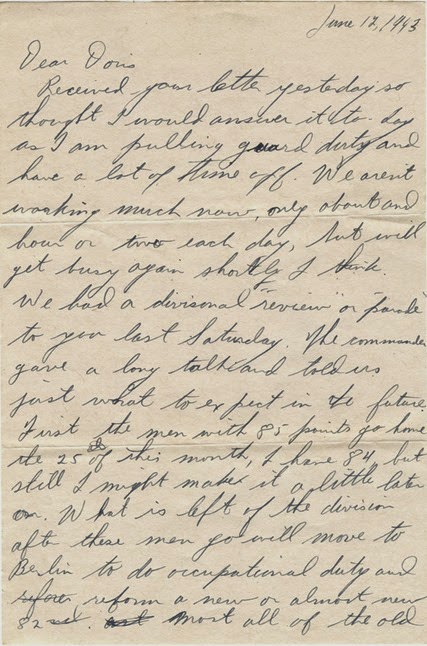
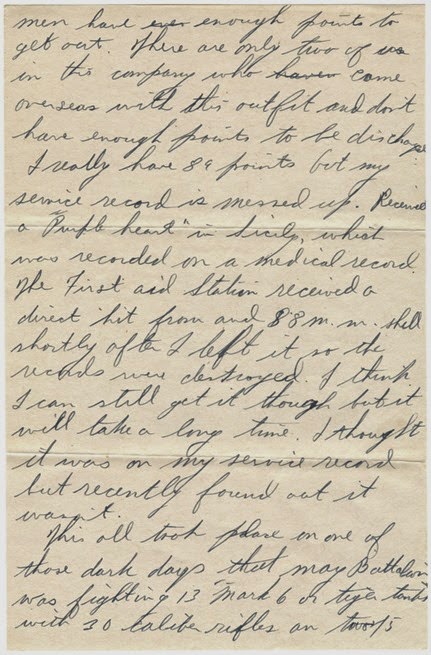
Page 1 and 2 of Bill’s letter
Pages 3 and 4 of Bill’s letter
Page 5 of Bill’s Letter
© Copyright Jeffrey Clark 2014 All Rights Reserved.



